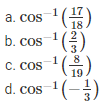NEET Physics is the scoring paper in the medical entrance examination. Here, you will discover the NEET Physics MCQ Questions for all Concepts as per the latest syllabus. Practice more on a regular basis with these NEET Physics objective questions on air pollution and improve your subject knowledge & problem-solving skills along with time management. NEET Physics Equilibrium of Forces Multiple Choice Questions make you feel confident in answering the question in the exam & increases your scores to high.
MCQ on Equilibrium of Forces
1. How is the weight of the aeroplane flying in the air balanced?
(a) The weight is balanced because of the force due to the pressure difference between the upper and lower surfaces of the wings created by different airspeeds on the surfaces.
(b) The weight is balanced due to the vertical component of the thrust created by air currents striking the lower surface of the wings
(c) The weight is balanced due to the force produced when the reactions of gases are ejected by the revolving propellor.
(d) Upthrust of the air which will be equal to the weight of the air having the same volume as the plane
Answer
Answer: (a) The weight is balanced because of the force due to the pressure difference between the upper and lower surfaces of the wings created by different airspeeds on the surfaces.
2. Which of the following is true when a body is stationary?
(a) The force acting on it is not in contact with it
(b) The body is in vacuum
(c) There is no force acting on it
(d) The combination of forces acting on it balance each other
Answer
Answer: (d) The combination of forces acting on it balance each other
3. Two forces with magnitude F have the resultant of same magnitude F. What is the angle between the forces?
(a) 450
(b) 600
(c) 1200
(d) 1500
Answer
Answer: (c) 1200
4. What is the angle between the forces if two forces with equal magnitudes F act on a body and the magnitude of the resultant force is F/3?

Answer
Answer: (a) \(\cos ^{-1}\left(\frac{17}{18}\right)\)
5. In which direction should the force be applied to balance a force in the direction of North-East direction?
(a) South
(b) West
(c) South-West
(d) North-East
Answer
Answer: (c) South-West
6. Among the following which cannot be a resultant force of 5 N and 10 N?
(a) 4 N
(b) 5 N
(c) 8 N
(d) 12 N
Answer
Answer: (a) 4 N
7. The resultant of the two forces are perpendicular to the smaller of the two forces. The magnitude of one of the forces is double the magnitude of the other force. What is the angle between the forces?
(a) 600
(b) 900
(c) 1200
(d) 1500
Answer
Answer: (c) 1200
8. Which of the following depictions correctly shows the vector addition of forces \(\overrightarrow{F_{1}}\) and \(\overrightarrow{F_{2}}\) to yield a third force \(\overrightarrow{F_{3}}\)?
9. Which of the following sets of concurrent forces are in equilibrium?
(a) F1=3N,F2=5N,F3=1N
(b) F1=3N,F2=5N,F3=6N
(c) F1=3N,F2=5N,F3=9N
(d) F1=3N,F2=5N,F3=15N
Answer
Answer: (b) F1=3N,F2=5N,F3=6N
10. Two blocks connected to each other by a string is hung to the ceiling by connecting another string to the upper block. When a force F is applied on the string, it produces an acceleration of 2 m/s2. If T and T’ are the tensions in two parts of the string, then which of the following is true?
(a) T = 70.8 N and T’= 47.2 N
(b) T = 70.8 N and T’= 0
(c) T = 70.8 N and T’= 58.8 N
(d) T = 58.8 N and T’= 47.2 N
Answer
Answer: (a) T = 70.8 N and T’= 47.2 N
11. Consider the blocks shown in the diagram to be pushed against a frictionless table by a constant force. Following statements are said about the blocks:
- All blocks move with the same acceleration
- The net force on all the blocks is the same
Which of these statements is true?
(a) Both A and B
(b) Neither A and B
(c) Only A
(d) Only B
Answer
Answer: (c) Only A
